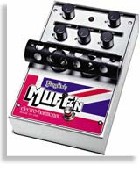
For the last 37-plus years, Electro-Harmonix has been a prolific innovator and manufacturer of effects pedals and other preamp devices. A few times each year, E-H president Mike Matthews offers up something different and unexpected, but it always sounds great, offers gig-proof durability, has that all-important retro vibe, and has a high bang-for-the-buck factor.
The latest E-H offerings are the Polyphonic Octave Generator (friends call it “POG”) and the English Muff’n, a British-flavored tube overdrive preamp.
The English Muff’n has the familiar E-H two-preamp-tube layout and chassis (seen most recently on the Black Finger compressor, Wiggler, and Tube EQ) and ships with a 12-volt AC power supply in that handy plywood box. To test the Muff’n, we used an Ampeg Super Rocket 2×12″ tube combo and all-tube Crate head with a 4×12″ Celestion-loaded cabinet. We tested the unit plugged into both amps’ regular inputs to see how they interacted with the amplifier’s preamp, and then running straight into the power amp section.
The English Muff’n features two E-H 6072A/12AY7 preamp tubes protected by an anodized shield, with controls for Volume, Gain, and High, Mid, and Low tone, as well as isolated 1?4″ in/out jacks and two LEDs, one to indicate the unit has power and one to indicate whether it’s on or in bypass mode.
We first checked the Muff’n with a humbucker-loaded Fender Flame through the Ampeg, with the pedal’s gain turned almost all the way down. Immediately notable are the tone controls’ very smooth, sweet voicing that stays musical regardless of where they’re set. The High control adds presence and sizzle, but no harshness, while the Mid adds not only warm, smooth midrange, but an upper-midrange attack that makes notes pop. The Low control keeps the sound tight and round while filling out low-end. As we turned up the gain to add overdrive, cranked the Low and Mid controls, and set the High at 9 o’clock, we got a creamy Vox-like tone with fantastic note separation that reacted well to playing touch. With the Mid dialed almost out and High turned up a bit, the pedal offered a completely different sound – more airy, with a lively shimmer to the highs that was very open when we played open chords. With the unit plugged into the line-in of the Ampeg (bypassing the preamp) the tone was even tighter and smoother, with less noise. We got very similar results with the Crate half-stack, but with more low-end thump and a midrange peak.
Though the manual doesn’t make mention of it, the Muff’n can use tubes other than those supplied with it; a 12AX7 in the post-gain position will give bigger, more aggressive output. Or a 12AX7 in the preamp makes for a more-aggressive drive stage rounded out by the 12AY7 in the output stage.
We also tried a 12AU in both the in and output stages, and mixed them with AX and AY tubes for a totally different sound. E-H tells us they tested the Muff’n in its prototype stage and discovered the differences; they were not drastic, but were enough to expose the potential sound of different tubes.
The POG shares the familiar 77/8″ x 63?4″ x 11?2″ brushed steel chassis and comes with a 18-volt DC power supply. Controls are faders for Input Gain, Dry Signal (amount of guitar’s natural sound goes to output), Octave, Low-Pass Filter, and a three-way mode switch.
The Sub Octave fader adds a tone one octave below the original; the faders for the first octave add a tone one octave above the original, and another one octave above that and is slightly detuned, while the second octave fader did the same, but two octaves above the original.
With the dry control set at about 75 percent and the first octave fader at about 50 percent, we achieved a decent 12-string guitar sound. We used both first octave faders to get the slight chorus effect you’d get with a 12-string. With the low-pass filter switch in mode one (where it effects only the octave generator, not the dry signal) we could dial back some of the shrill on the high E and B strings.
Using only the sub-octave generator and a little bit of the dry signal with the low pass filter in mode three (effect both the tone generator and the dry signal) a got a surprisingly fat and usable bass guitar sound.
With all three octave generators turned up, we got a surprisingly good organ sound that tracked very well. We turned up the Input fader and drove the unit into a bit of distortion, it simulated the percussive reminiscent of a Hammond organ.
Both of E-H’s new pedals deliver great sounds, are easy to operate, and a blast to play with.
Electro-Harmonix English Muffin
Features True-bypass foot switches, heavy-duty steel chassis, status LEDs, dual 6072A/12AY7EH preamp tubes, three-band interactive tone control.
Price $298.
Electro-Harmonix POG
Features True-bypass footswitches, heavy duty steel chassis, status LEDs, switchable low-pass filter, three-octave capability.
Price $690.
Contact Electro-Harmonix/New Sensor, 32-33 47th Ave. LIC, New York NY 11101; www.ehx.com.
This article originally appeared in VG‘s Jul. ’05 issue. All copyrights are by the author and Vintage Guitar magazine. Unauthorized replication or use is strictly prohibited.



